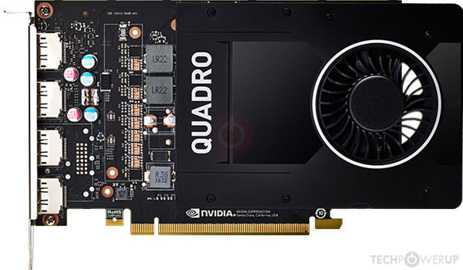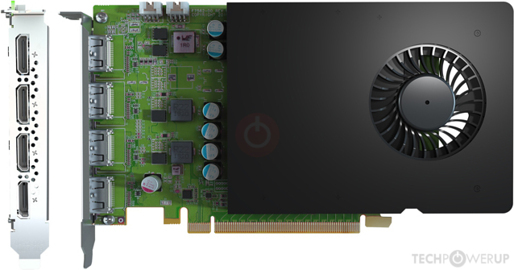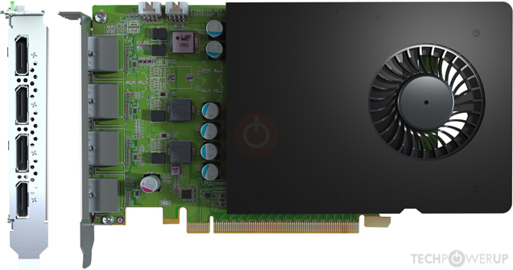- Joined
- Oct 9, 2007
- Messages
- 47,895 (7.38/day)
- Location
- Dublin, Ireland
| System Name | RBMK-1000 |
|---|---|
| Processor | AMD Ryzen 7 5700G |
| Motherboard | Gigabyte B550 AORUS Elite V2 |
| Cooling | DeepCool Gammax L240 V2 |
| Memory | 2x 16GB DDR4-3200 |
| Video Card(s) | Galax RTX 4070 Ti EX |
| Storage | Samsung 990 1TB |
| Display(s) | BenQ 1440p 60 Hz 27-inch |
| Case | Corsair Carbide 100R |
| Audio Device(s) | ASUS SupremeFX S1220A |
| Power Supply | Cooler Master MWE Gold 650W |
| Mouse | ASUS ROG Strix Impact |
| Keyboard | Gamdias Hermes E2 |
| Software | Windows 11 Pro |
Matrox is pleased to announce that the Matrox D-Series D1480 multi-display graphics card is now shipping. Purpose-built to power next-generation video walls, this new single-slot graphics card supports up to four 4Kp60 DisplayPort monitors and can be combined to drive a high-density-output video wall of up 16 synchronized 4K displays. Along with a rich assortment of video wall software and developer tools, the D1480 card enables OEMs, system integrators, and AV installers to deploy high-performance display walls for a broad range of commercial and critical 24/7 applications, including control rooms, enterprises, industries, government, military, digital signage, broadcast, and more.
Backed by innovative technology and deep industry expertise, D1480 delivers exceptional video and graphics performance on up to four 4K DisplayPort monitors from a single-slot card. OEMs, system integrators, and AV professionals can easily add—and synchronize—displays by framelocking up to four D-Series cards via board-to-board framelock cables. In addition, D1480 offers HDCP support to display copy-protected content, as well as Microsoft DirectX 12, OpenGL 4.5, and OpenCL 1.2 support to run the latest professional applications.
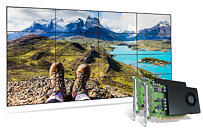
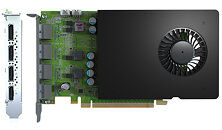
Proven video wall ecosystem
D-Series cards work seamlessly with Matrox's complete video wall portfolio. OEMs and system integrators can pair D1480 with Matrox Mura IPX capture cards to add advanced HDCP functionality to capture and display content-protected sources—including set-top boxes, Blu-ray Disc and media players, and video game consoles. D-Series can also be combined with Matrox QuadHead2Go multi-monitor controllers to create ultra-large-scale configurations of up to 64 x 1920x1080p60 screens.
Custom Control
D-Series includes the robust and field-proven Matrox PowerDesk desktop management software. Users can select from a variety of advanced tools—including stretched or independent desktops, clone mode, pivot, bezel management, edge overlap, and more—to easily configure and customize multi-display setups. The feature-rich Matrox MuraControl video wall management software meanwhile provides users with an intuitive platform to manage video wall sources and layouts either locally or remotely, and in real time. Matrox video wall APIs, SDKs, and libraries are also available for developers and AV installers interested in creating custom control functions and applications.
"The new Matrox D-Series card enables customers to go beyond 'standard' and explore new levels of video wall creativity," said Fadhl Al-Bayaty, business development manager, Matrox. "Video wall designers can now capture and display HDCP sources, run computationally-intensive applications locally, deploy ultra-high-density-output platforms, and much more—all while benefiting from a high-performance, high-reliability video wall architecture."
For more information, visit the product page.
View at TechPowerUp Main Site
Backed by innovative technology and deep industry expertise, D1480 delivers exceptional video and graphics performance on up to four 4K DisplayPort monitors from a single-slot card. OEMs, system integrators, and AV professionals can easily add—and synchronize—displays by framelocking up to four D-Series cards via board-to-board framelock cables. In addition, D1480 offers HDCP support to display copy-protected content, as well as Microsoft DirectX 12, OpenGL 4.5, and OpenCL 1.2 support to run the latest professional applications.


Proven video wall ecosystem
D-Series cards work seamlessly with Matrox's complete video wall portfolio. OEMs and system integrators can pair D1480 with Matrox Mura IPX capture cards to add advanced HDCP functionality to capture and display content-protected sources—including set-top boxes, Blu-ray Disc and media players, and video game consoles. D-Series can also be combined with Matrox QuadHead2Go multi-monitor controllers to create ultra-large-scale configurations of up to 64 x 1920x1080p60 screens.
Custom Control
D-Series includes the robust and field-proven Matrox PowerDesk desktop management software. Users can select from a variety of advanced tools—including stretched or independent desktops, clone mode, pivot, bezel management, edge overlap, and more—to easily configure and customize multi-display setups. The feature-rich Matrox MuraControl video wall management software meanwhile provides users with an intuitive platform to manage video wall sources and layouts either locally or remotely, and in real time. Matrox video wall APIs, SDKs, and libraries are also available for developers and AV installers interested in creating custom control functions and applications.
"The new Matrox D-Series card enables customers to go beyond 'standard' and explore new levels of video wall creativity," said Fadhl Al-Bayaty, business development manager, Matrox. "Video wall designers can now capture and display HDCP sources, run computationally-intensive applications locally, deploy ultra-high-density-output platforms, and much more—all while benefiting from a high-performance, high-reliability video wall architecture."
For more information, visit the product page.
View at TechPowerUp Main Site




 .
.